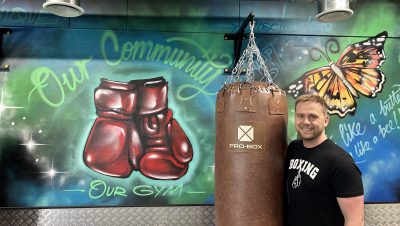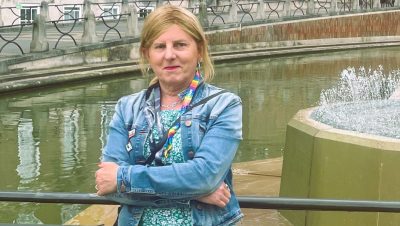Features / Invisible Disabilities
Living with invisible disabilities: Izzy’s Story
Izzy is nine and she enjoys doing everything a child of her age likes doing: trampolining, swimming, seeing her friends and watching her favourite shows.
But she also lives with a life-threatening condition – not that you would know from looking at her her mum says. This is because she has an invisible disability.
Izzy has been in-and-out of hospital from before she could walk due to kidney failure.
is needed now More than ever
While Izzy has since had a kidney transplant, the years leading up to and since have still been marred with challenges that impact her and her families day-to-day life, some more serious than others.
Her mum Emma Headings sat down with us to discuss their experience, the support they’ve received and how they often feel like they’ve got a foot in both camps.

Emma says its easy to get carried away with how normal presenting they are. “It’s not hindering her, but it is something we have to be careful about as people don’t realise what’s going on behind the scenes with that side of things.” – photo: Family
Izzy was not only born with kidney failure but she was also five-weeks premature, multiple complications ensued.
Emma states plainly:”It a pretty traumatic entrance into life for her. She spent the first three years of her life in-and-out of Bristol Children’s Hospital.
“Then when she was at home she was on a dialysis machine overnight and every night.”
Subsequently she ended up on hemodialysis, which is used when very little kidney function remains. For this they had to go to the Children’s Hospital three to four times a week for about 18 months. It’s crucial you don’t miss any.
“It’s a very hidden disability because with kidney failure you look okay. I’m sure you have probably walked past people on the street who who are on dialysis that look fine, but actually are probably feeling quite sick.
“They’ll be very tired, they’ll probably be a bit malnourished, their bones will be weak because your kidneys control how your bones are formed.”
In Izzy’s case, the first few years of her life leading up to the transplant were marked by delayed developmental skills, bowed legs and wrists and the development of osteoporosis.
She couldn’t walk much and struggled to eat, which led to the need for a discreet feeding tube that goes directly into her stomach—a necessity she still relies on today due to an aversion she developed.
When she was on hemodialysis the line would be placed under a clothes, which Emma tells me “is a lifesaver but it’s also a huge infection risk. So, you’ve got to look after them really, really well.”
The risks are life threatening and omnipresent.
But children in general are very resilient says Emma. “In the beginning she didn’t know any different. She still laughed and smiled and would join in with things. She thought it was, I suppose, normal to throw up three or five times a day.”
As well as the time leading up to a kidney transplant, if a person successfully receives the donation they need, there is then an extended period of at least six weeks for parents out of work.
It’s typically two weeks in hospital, then isolation for four or five weeks until the drug levels lower, the body adjusts and their immune system can build.
For parents of children with invisible disabilities the responsibilities become all consuming.
“I always say that I have many roles: I’m a mum, a wife, I have my career and I would also say I’m Izzy’s personal assistant, alongside my husband, Neil.
“She has her hospital appointments every other week, her daily medical care and the paperwork that goes with everything.”
Emma works at a university three days-a-week and she says throughout it they were very flexible. Likewise her husband’s company gave him time off before allowing him a staggered return.
Further to that he has progressed within the company since, which Emma admits is great that one of them got to do so as it is so rarely the case that jobs and careers are flexible to big-life events like this.
“I think it’s quite important that you have something else to think about that isn’t to do with your family,” she says.
“We have been lucky we’ve had employers that have been supported, but not everyone gets that. I know of parents that were self-employed and are still suffering years on from the financial burden.”
It is also a postcode lottery for those in-need of specialist care. Emma tells me they have friends who travel for more than four hours from places such as Lands End, Cornwall and London.
When her friends’ children are in the unit receiving dialysis, they cannot simply just go home for the night, unlike themselves for which it is a 20-minute drive from where they live in Cheswick Village.
This is a routine that is repeated four times a week for several years, making fitting in regular life impossible and setting some parents back years in their own lives.
“You don’t really think about where you’re living in that sense when you have a child,” she says with a heavy heart.

Jessie May nurses have been right there alongside Izzy, advocating for her needs before she could even walk and talk – photo: Family
After the transplant, there was a massive improvement in Izzy’s life quality. But there are life lasting effects of having had kidney disease and the resulting transplant.
Most children born with kidney disease develop bladder issues as the bladder doesn’t always form correctly. When they need to use the bathroom, the need is often urgent and uncontrollable, some require catheterisation, others will be in nappies.
She now has scoliosis which is something she manages with a brace, but there are concerns of how that will play out over the coming years.
She reiterates that she looks like a normal, healthy kid on the outside, but because of this, she has become hyper-aware of people’s perceptions: the extended stares when they’re able to leap to the front of a queue, the scanning for a blue badge when they pull into a disabled parking space, or the lingering looks over Izzy, as people search for some visible sign of a disability while she queues for the disabled toilet.
Throughout the conversation she says “we aren’t trying to pull a fast one on people.” The sense to prove that they are justified in using these resources is constant.
Conversely you can sense the anger at the injustice at having to explain herself to those without disabilities who constantly seek confirmation, proof even.
These experiences, paired with the invisible nature of conditions like Izzy has even had her parents questioning their worthiness to receive the treatment and support that those with conditions more obvious receive. Guilt even.
The nurses at Jessie May have been consistently providing respite for the family as well as other children. It’s in spaces like this when surrounded by visible disability that this imposter syndrome sets in.
Emma remarks at how “ridiculous” it is that she questions it, but she does express guilt sometimes for using space and time, with the nurses having to remind her that she has every right to be there using their facilities.
“You know, we forget that her hospital appointments are weekly at the moment. She’s got injections to have soon, so you have to re-remind yourself she has got vulnerabilities. It’s a case of it becomes your norm.”
Whereas when she thinks about her other six-year-old boy and the difference in lifestyles, “how quick and easy it is with him. If we take him out, I don’t have to think about whether we have spare clothes, feed or medicines.”
This guilt and conflict is a theme that appears to weave itself into many areas of their lives.
This is made far worse, when like a lot of people living with invisible disabilities they have been verbally challenged by others.
On the experience she says: “It was quite upsetting because I thought I shouldn’t have to explain to you why we have a disabled parking space and what’s wrong with my child.”
The other part of that is because Izzy is now coming of an age where she is becoming more autonomous and more aware of the external world, her parents are conscious of what they tell and to who.
She will also soon have to deal with the common challenges that arise when kids transition into teenagers, into secondary school, all the while with the complexity of a life-long condition.
“Yes, I’m not looking forward to adolescent years, they always say for transplants the most dangerous years for the transplants to fail quite often with children are the adolescent years because they start rebelling.
“Because they have more responsibility to take their tablets and things every day. Some of them stop taking them because they don’t want to. They feel fine and they feel invincible a little bit and their mates aren’t doing it.
“They need to really be on board with their health condition and accepting things, which I think is really hard at that age.
“You have got everything else going on in your life. and you’ve got this thing on top.”
These changes are already happening as demonstrated recently when Izzy brought up to her mum that she is the only one who regularly leaves class for a medical reason.
In response to that Emma assured her: “Some other children that you know, probably have got some conditions or things such as learning difficulties who probably are going out too. It’s not just you.”
Adding, “She’s obviously much more aware of that now.”

Izzy with Jessie May nurse Steve who along with the regular nurses have seen her grow up – photo: Jessie May
Having a child with an invisible disability, also put the family in the unusual position of a “being in two camps” as described by Emma.
“When you’ve got an invisible disability, you’ve kind of got that opportunity to not be seen as disabled, because it’s not obvious that you’ve got some disabilities.
“It’s nice that people aren’t constantly looking at us and thinking poor them or isn’t awful?
“But then at the same time, you do need some support.
“You want to be an advocate for your disability, but you probably don’t want too much attention on it either. It’s nice to live in a world where you’re not constantly under scrutiny, especially when you don’t have something as obvious as a wheelchair or a visible difference drawing people’s stares.”
Izzy goes to a mainstream school, where Emma keenly highlights they’ve been really supportive. But there aren’t many kids like Izzy.
“I don’t quite connect with the parents who’ve got children who are nonverbal, or can’t move and have a really quite a different lifestyle. Conversely parents whose children are completely healthy, I don’t quite relate to them either.”
Its an identity crisis almost, but their experience coupled with their friends who have children with disabilities and those who don’t, has opened their eyes to what more could be done to be inclusive of all.
“When you start thinking about it from a different perspective, you notice these things.”
She stresses that “it is all these little barriers that make life a little bit harder than it should be.
“We don’t tend to use public transport, generally we drive to hospital, because the buses to the hospital are terrible.”
The few times they have used buses access has been an issue, a particular memory stands out of attempting to board the connecting bus on their journey and not being able to get her double buggy round the interior of the bus.
She says: “I ended up having to get the kids out and collapsing the buggy, which was fine because I wasn’t on my own. But had I been, that would have been the end of the trip.”
It prompted her to think about those in electric wheelchairs, or people with medical equipment attached.
If you are able to go by car, or taxi which is offered to those on dialysis, you have to take their overnight bag and a car seat.
“You have to take it out of the taxi and ask them if they can store it somewhere in the hospital, then you end up carrying it, along with the children, to the fourth floor or whatever. So, it’s not an easy option either.”
Toilets she says is an obvious one, but even within the hospital she says the facilities aren’t adequate for common tasks in a hospital such as getting a urine sample. Little changes like a shelf, or a child’s level sink and dryer would make all the difference.
Or even a sign on the door of the disabled toilets that reads ‘Not all disabilities are visible’, she thinks could positively wire people’s perception to openness, rather than to default to judgement.
She says: “Accessibility seems like an afterthought. When you make things accessible, you make it useful for everybody.”
Main photo: Emma Headings
Read next:
 Our newsletters emailed directly to you
Our newsletters emailed directly to you




















